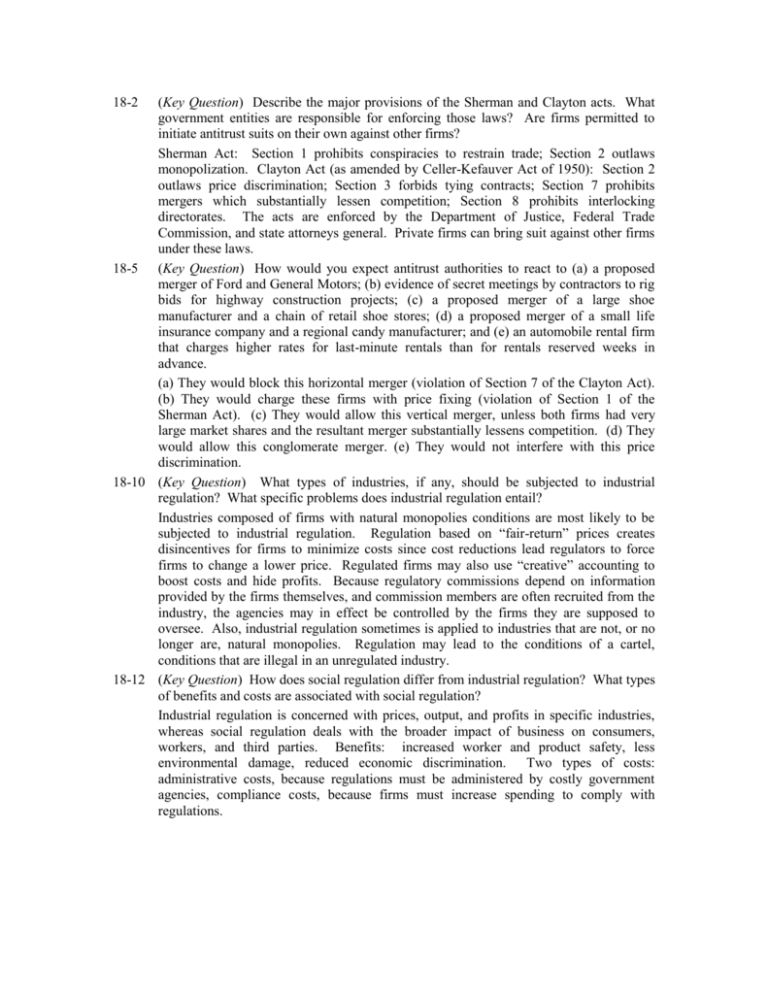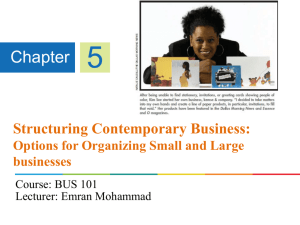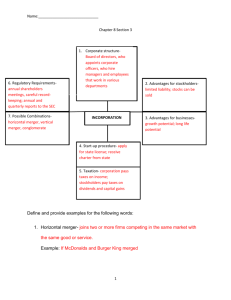Chapter 18 Key Question Solutions
advertisement

18-2 (Key Question) Describe the major provisions of the Sherman and Clayton acts. What government entities are responsible for enforcing those laws? Are firms permitted to initiate antitrust suits on their own against other firms? Sherman Act: Section 1 prohibits conspiracies to restrain trade; Section 2 outlaws monopolization. Clayton Act (as amended by Celler-Kefauver Act of 1950): Section 2 outlaws price discrimination; Section 3 forbids tying contracts; Section 7 prohibits mergers which substantially lessen competition; Section 8 prohibits interlocking directorates. The acts are enforced by the Department of Justice, Federal Trade Commission, and state attorneys general. Private firms can bring suit against other firms under these laws. 18-5 (Key Question) How would you expect antitrust authorities to react to (a) a proposed merger of Ford and General Motors; (b) evidence of secret meetings by contractors to rig bids for highway construction projects; (c) a proposed merger of a large shoe manufacturer and a chain of retail shoe stores; (d) a proposed merger of a small life insurance company and a regional candy manufacturer; and (e) an automobile rental firm that charges higher rates for last-minute rentals than for rentals reserved weeks in advance. (a) They would block this horizontal merger (violation of Section 7 of the Clayton Act). (b) They would charge these firms with price fixing (violation of Section 1 of the Sherman Act). (c) They would allow this vertical merger, unless both firms had very large market shares and the resultant merger substantially lessens competition. (d) They would allow this conglomerate merger. (e) They would not interfere with this price discrimination. 18-10 (Key Question) What types of industries, if any, should be subjected to industrial regulation? What specific problems does industrial regulation entail? Industries composed of firms with natural monopolies conditions are most likely to be subjected to industrial regulation. Regulation based on “fair-return” prices creates disincentives for firms to minimize costs since cost reductions lead regulators to force firms to change a lower price. Regulated firms may also use “creative” accounting to boost costs and hide profits. Because regulatory commissions depend on information provided by the firms themselves, and commission members are often recruited from the industry, the agencies may in effect be controlled by the firms they are supposed to oversee. Also, industrial regulation sometimes is applied to industries that are not, or no longer are, natural monopolies. Regulation may lead to the conditions of a cartel, conditions that are illegal in an unregulated industry. 18-12 (Key Question) How does social regulation differ from industrial regulation? What types of benefits and costs are associated with social regulation? Industrial regulation is concerned with prices, output, and profits in specific industries, whereas social regulation deals with the broader impact of business on consumers, workers, and third parties. Benefits: increased worker and product safety, less environmental damage, reduced economic discrimination. Two types of costs: administrative costs, because regulations must be administered by costly government agencies, compliance costs, because firms must increase spending to comply with regulations.











